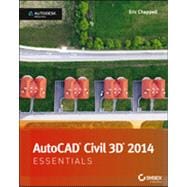Quickly learn essential Civil 3D tools and techniques
Get a thorough introduction to AutoCAD Civil 3D, the industry-leading engineering software used to design roads, highways, subdivisions, drainage and sewer systems, and more. This Autodesk Official Press book is a unique learning resource that features concise, straightforward explanations and real-world, hands-on exercises and tutorials. With compelling full-color screenshots and approachable exercises that demonstrate core features and functions, the book helps you gain understanding and confidence as you master this premiere civil engineering software.
- Introduces the software's interface and foundational concepts
- Follows a workflow-based approach that mirrors how projects progress in the real world, and guides you through importing and working with field survey data, managing point data with groups and styles, and modeling terrain using surfaces
- Covers creating and editing alignments and profiles, designing 3D road models, building and analyzing terrain models, designing and analyzing pipe networks, and much more
- Shows how to estimate quantities and create construction documentation
- Provides information to help you prepare for the Civil 3D certification exam
AutoCAD Civil 3D Essentials is the perfect, real-world introduction to the powerful civil engineering software.








